- This topic has 21 replies, 6 voices, and was last updated 7 years, 6 months ago by
 Alex Pratt.
Alex Pratt.
-
AuthorPosts
-
8 November 2017 at 9:51 pm #573886
 Bill WardParticipant
Bill WardParticipantHi all,
I few years back I read a paper about an alternative to the standard rotating shutter used in meteor observing. Having gathered together a collection of older generation DSLR’s I wanted to find some way of bringing them into use. Meteor “photography” is almost trival now compared to the days of film! However using DSLR’s still has some difficulties. Apart from actually catching any meteors at all (nothing new there… ;-)) DSLR’s seem to singularly good at recording satellites. Mostly it is possible to tell what is a bright meteor and what is a satellite. However on a still images there are sometimes ambiguities especially with faint meteors. Although ostensibly for measuring velocity properties of meteors the rapid chop can be useful for discriminating between satellites and meteors.
Meteors are fast thus giving the broken line appearence on photographs. Satellites, on the other hand are, relatively speaking much slower, therefore with a fast chop those chopped bits overlap and the satellite still looks like an unbroken line.
With the greater utility of DSLR’s this is a good first guide to tell if you have a satellite or a meteor.
The mechanical shutter involves a larger shutter element driven by a motor. Some systems have proven very reliable but newer technology offers an alternative. Using a small liquid crystal element mounted in from of the lens driven by an appropriate signal generator can function in the same way a rotating chopper.
Here’s a pic of one of the two 50mm LC shutters I use. For the moment it is simply held with a lens hood using “optical putty” aka BluTac!
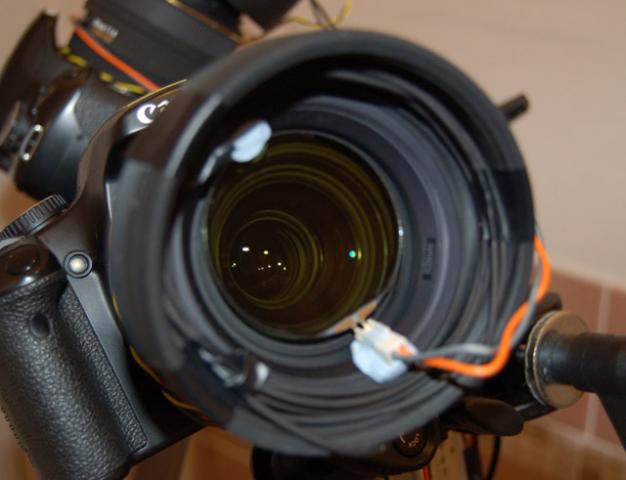
To ensure correct operation the LC element must be driven with the correct plus and minus voltage. That is it needs to see a -volt signal then a +volt signal and so on. Not from zero volts to a max as this causes the LC component not to switch between transparent and dark fully, thus degrading the crystals. To achieve the correct voltages I use a programmable function generator. Using a two channel version allows me to drive both shutters from the one unit.
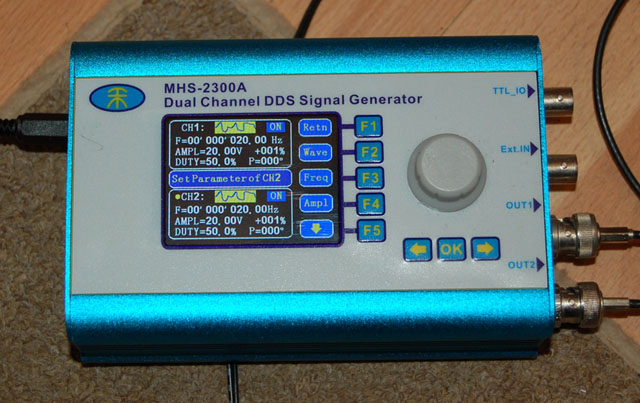
This particular unit needs a 5 volt power supply so I had had to get a DC/DC converter to take the 12v car batterey voltage down to the 5v needed. (No endorsement as they are tax avoiding bampots, but these things are very cheap from various dealers on Amazon.)
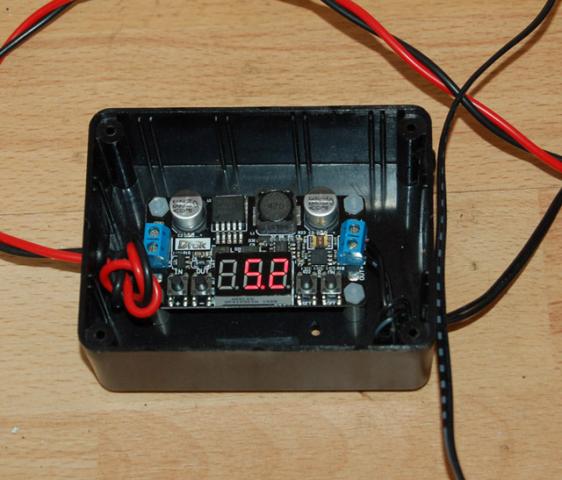
It took some 12 hours observing and 1000+ exposures over several nights to get a result but it works!
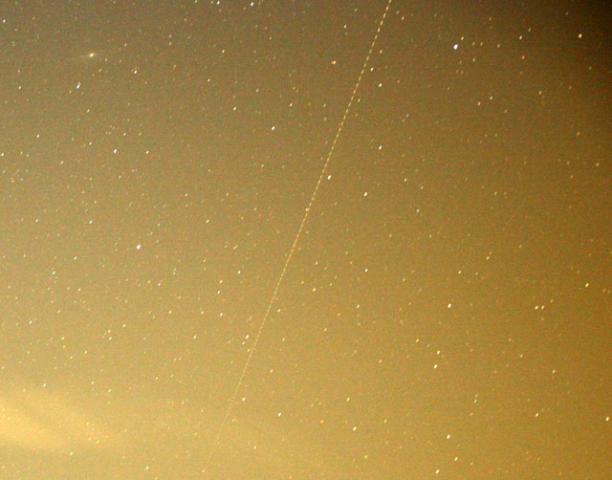
This is a (stretched) crop from the original frame. This was taken with a Canon 450D 30mm f1.4 lens 27second exposure at iso1600. Chop rate 20Hz. M31 can be seen top left to give some sense of scale. Due to my general laziness I forgot to correct the clock from BST to UT and there was a large amount of drift so there is some timing ambuguity. Mike Foylan caught what might be the same meteor on video. Long lasting 3-4 seconds and in the right part of the sky from his location, Co Meath Ireland, it looks pretty good.

The system seems to have promise but it has definite limitations. the LC shutter itself has a transparency of just over 40% so there is a magnitude loss to be reckoned with. A fast lens or higher ISO can mitigate this to some extent. It is more complex electronically than a mechanical job but easier to handle. A really useful aspect is the ability to change the chopping frequency easily. It’s almost a way to optimise the results on a particular velocity of meteor. Time will tell….
Hopefully the Leonids will yield some more results. If so I’ll post them here.
Cheers,
Bill.
PS. Thanks to Mike and the other Nemetoders for taking the time to check their images.
8 November 2017 at 10:33 pm #578737 Callum PotterKeymaster
Callum PotterKeymasterHi Bill,
I noticed a couple of your twitter postings on this, so good to see a write up!
Where do you get the LC shutters from?
Cheers, Callum
9 November 2017 at 3:37 pm #578740 Bill WardParticipant
Bill WardParticipantHi,
The shutters were supplied by this company.
However, I got mine via a friend in the Netherlands as he was ordering several for the same use. I don’t know for sure but there may have been a minimum order quantity. A single shutter is around Euro 200-250 depending on model.
cheers,
Bill.
9 November 2017 at 7:32 pm #578744 William StewartParticipant
William StewartParticipantHi Bill,
If you’re confident that Mike’s video image composite is the same event as your DSLR image then I caught it too (well, part of it). Will send pm to Mike and yourself to triangulate ground-track and confirm shower association (single-station has it as a Northern Taurid).
Best regards
William
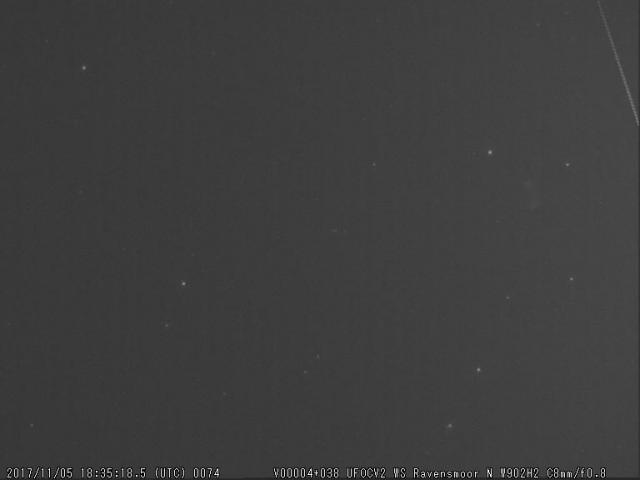 9 November 2017 at 9:52 pm #578749
9 November 2017 at 9:52 pm #578749 Bill WardParticipant
Bill WardParticipantHi,
Perhaps not “confident” as there is still a timing error but the trail length and relatively slow speed make it “definite” maybe….
Certainly was travelling in the correct direction for a possible N Taurid.
cheers,
Bill.
11 November 2017 at 11:28 pm #578756 Bill WardParticipant
Bill WardParticipantThanks to the efforts of Mike and William this is looking like a good candidate. Whilst there is still a timing issue on my part the az and alt of my camera are in the correct direction.
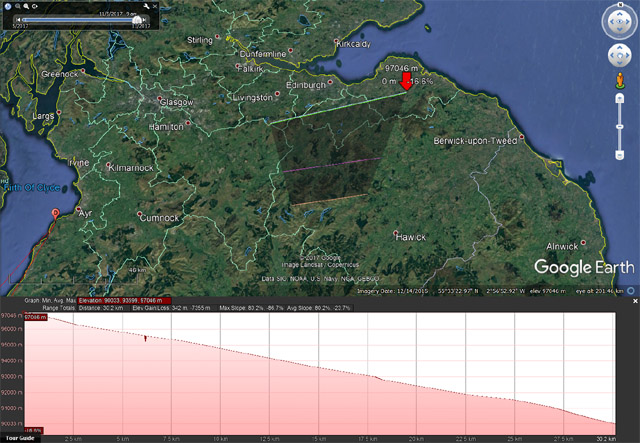
Due to resizing the image to fit it’s a bit difficult to see the numbers on the graphic. The meteor trail starts at 97 km and decends to 90km over a 30km path.
Image courtesy of Mike Folan.
cheers,
Bill.
21 May 2018 at 8:54 pm #579517 Bill WardParticipant
Bill WardParticipantA rather late follow up. One of the issues that originally confused me was the duration of the meteor from video compared to the duration determined by the chops in my still. After some tests with my system and an oscilloscope there is an effective doubling of the chops due to the way the crystals in the shutter work.
In this case the function generator was producing a square wave at 20Hz (20 times per sec) HOWEVER the crystals seem to switch with every reversal of voltage so a 20Hz rate from the function generator gives 40 chops per second. What this boils down to is that the meteor was only half as long as I originally thought but now it fits much better ;-))
Further digging around reveals that driving them this way, with a pos-neg-pos-neg voltage etc signal a: makes them work properly and b: if you use, say, zero-pos-zero etc it can cause the crystal to degrade much quicker (according to the manufacturer’s bumff.)
So, beware if you use these LC shutters, they might not give you what you think they should be giving you…!
I am now confident it was the same meteor.
Cheers,
Bill.
22 May 2018 at 7:59 pm #579520 Grant PrivettParticipant
Grant PrivettParticipantThats a really neat idea and I can see applications in other fields. How opaque do they become when energised? What sort of attenuation level could we hope for?
I programmed a mechanical shutter to go off multiple time during a single Starlight H18 CCD exposure but, due to the time taken for the shutter to operate, its its not really plausible to work much above 5Hz and even then you are knackering the shutter mechanism, if you run it for long.
Thanks for the report.
23 May 2018 at 2:54 pm #579523 Bill WardParticipant
Bill WardParticipantHi,
If you have a look at the manufacturer’s website all the figures are there. I’m using a FOSG2 (circular version).
Off the top of my head it’s the transmission that is the problem. It’s only about 37% thus you’re losing ~ a stop. A fast lens is needed. The extinction ration is 1800:1. That’s dark enough for meteor work but whether this is sufficent for other imaging I’m not sure. The meteor image shows quite a clean profile, I pleased with the result (and if I’d paid more attention to the timing diagram on the website the actual chopping rate wouldn’t have been a surprise! ;-)). I’m currently constructing a ye olde fashioned rotating shutter for some other cameras so it’ll be interesting to compare the results….
cheers,
Bill.
24 May 2018 at 9:00 am #579525 Alex PrattParticipant
Alex PrattParticipantHi Bill,
I have one of the late Steve Evans’ stepper motor-driven rotating shutters from AWR Technology. He used this system with Canon T70 cameras – and in conjunction with video timings from Andrew Elliott and Tim Haymes et al – determined the solar system orbits of Geminids and other major showers. It’s much easier these days using video cameras and the latest software!
I’ve just tested the control box, stepper motor and cutaway shutter and it burst into life. The AWR Technology website describes this equipment, which might differ slightly from the items in my care.
You are welcome to have them for your ‘olde fashioned’ meteor work. I can bring the items to Stirling this weekend.
Cheers,
Alex.
24 May 2018 at 9:24 am #579526 Bill WardParticipant
Bill WardParticipantHi,
I’ve just sent you an email. Sounds good. See you on Saturday.
cheers,
Bill.
24 May 2018 at 9:42 pm #579528 Grant PrivettParticipant
Grant PrivettParticipantThanks for the info. Had assumed you had tried filtered and unfiltered driven pics to measure the actual extinction – as manufacturers have been known to hype things and accidentally forget to mention important caveats. Yeah, 37% is pretty painful though. Still worth thinking about though.
26 May 2018 at 10:17 pm #579538 Bill WardParticipant
Bill WardParticipantHi,
After collecting Steve Evans’ old system I gave it the once over. A few loose connections were tightened and I changed the power lead. Seems to work a treat now. Next thing is to determine the rpm and chop rate….
It’ll be interesting to compare the two methods (hopefully during the Perseids…)
Cheers,
Bill.
27 May 2018 at 9:59 am #579539 Dr Paul LeylandParticipant
Dr Paul LeylandParticipant“Next thing is to determine the rpm and chop rate….”
If you have access to a sillyscope it is very easy to determine chop rate to an accuracy of a few percent. Shine a laser pointer through the chopper at a photodiode and measure the voltage across the latter.
27 May 2018 at 7:29 pm #579544 Alex PrattParticipant
Alex PrattParticipantHi Bill,
Great to meet up at Stirling!
As discussed offline, I’m really pleased that you’ve got Steve Evans’ rotating shutter system up and running for long-duration operation. All members who knew Steve will be delighted to see any results you obtain with this kit.
Perhaps we can locate a paper or report by him documenting its chop rate etc., although I fully agree with the need to check and confirm its current performance.
Have fun!
Alex.
28 May 2018 at 3:27 pm #579550 Alex PrattParticipant
Alex PrattParticipantHi Bill,
Have a look at this JBAA paper by Steve Evans -1998 Aug Vol 108 No 4 pp. 204-206
and other references to stepper motor rotating shutter systems
1999 Dec Vol 109 No 6 p.3002001 Feb Vol 111 No 1 p.332001 Dec Vol 111 No 6 pp.337-3382002 Apr Vol 112 No 2 p.63 & p.94Cheers,Alex.28 May 2018 at 8:01 pm #579551 Bill WardParticipant
Bill WardParticipantHi,
That’s great. I’ll look them up…
cheers,
Bill.
29 May 2018 at 11:28 am #579553 Bill WardParticipant
Bill WardParticipantHi,
It’s interesting to read that the problems with astrometery are nothing new! It is probably the sole advantage of DSLR imaging over video. The precision is vastly better! Talking to Felix about the LCD shutters he tells me that this issue was one of the drivers for trying them despite their optical limitations.
I ran the LCD system I have for ~2 hours through the wee hours of Sunday morning but didn’t catch anything. Despite the near full moon and essentially twilight conditions through the night at my latitude, the DSLR images looked much better than I anticipated given the sky brightness. The only concession I made was reducing the ISO from 1600 to 800.
We’ll see how it goes.
Cheers,
Bill.
29 May 2018 at 8:23 pm #579554 Bill WardParticipant
Bill WardParticipantHi,
Tested the rotating shutter at lunchtime. It’s turning at a fair clip. Chop rate is 62.5Hz. This is faster than the LCD rate on the image from the earlier post. I think a shutter with 2 or 3 blades (20.83Hz and 31.25Hz respectively) may be better for more general purpose observing. Need to locate some suitable plastic sheet and get cutting….
cheers,
Bill.
cheers,
Bill.
29 May 2018 at 10:08 pm #579555 Alex PrattParticipant
Alex PrattParticipantHi Bill,
The longest focal length lenses in the NEMETODE network (12mm) can achieve reference star O-Cs of 0.5 arcmin, very similar to the CAMS and SonotaCo networks. HD video systems should surpass this, but they need beefy PCs to cope with the data bandwidth and data processing requirements.
Both SD and HD video systems have their uses in estimating meteor rates, radiants and solar system orbits. Let’s see what your DSLRs can do this summer.
Cheers,
Alex.
-
AuthorPosts
- You must be logged in to reply to this topic.
